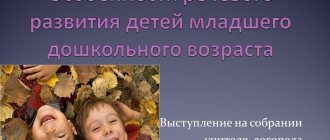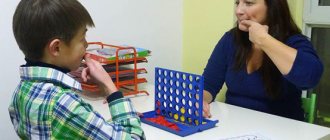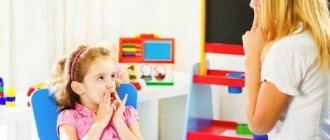Article:
Speech function is one of the most important mental functions of a person. In the process of speech development, higher forms of cognitive activity and the ability for conceptual thinking are formed.
The meaning of words in itself is a generalization and, in this regard, represents not only a unit of speech, but also a unit of thinking. In recent years, unfortunately, there has been an increase in the number of children with speech disorders.
Speech communication creates the necessary conditions for the development of various forms of activity and participation in collective work. A child’s mastery of speech contributes to awareness, planning and regulation of his behavior.
Speech disorders, to one degree or another, negatively affect the entire mental development of the child and affect his activities and behavior.
In our kindergarten, in the speech therapy group , there are children with speech disorders such as general underdevelopment of speech at various levels. Children with speech pathology are characterized by impaired gross and fine motor skills, and breathing is often shallow. Some are overly active, others are passive, which is due to the weakness of the nervous system. Aggression and excessive disinhibition are possible. Fatigue is often increased, attention deficit is observed, memory and performance are reduced.
to achieve positive results with such children only by creating a unified correctional and educational environment for preschool educational institutions. An integrated approach to speech correction ensures integrated connections between specialists working with children in the speech therapy group .
At the beginning of the school year, when checking the musical abilities of children in the speech therapy group, a general pattern is noted - children do not sing, but speak, cannot cope with singing sounds, pronouncing the endings of words, poorly remember the lyrics of songs, their names, names of musical works , do not sufficiently coordinate movements with the music , singing, in a word, they find it difficult to convey the rhythmic pattern. The listed characteristics of children determine the specifics of musical activity .
The main form of musical activity in preschool educational institutions is music classes , during which systematic, targeted and comprehensive education and formation of the musical and creative abilities of each child are carried out.
The specificity of musical work with children in speech therapy groups involves the use of elements of logorhythmics in each music lesson .
In the specialized literature, logorhythmics is considered as a system of musical-motor , speech-motor and musical-speech games and exercises carried out for the purpose of speech therapy correction (Volkova G. A. Logopedic rhythm . - M.: Prosveshchenie, 1985). Thus, speech development is formed through words, movement and music .
Logorhythmic activity includes the following elements:
1. Articulation gymnastics
- these are special exercises that set the human speech apparatus in motion
Objectives of articulatory gymnastics in music classes :
* develop children's singing abilities
* form articulation of various sounds.
* consolidate the articulatory patterns of these sounds in syllables, words, phrases.
* develop children's diction by training the mobility of tongue and lip movements
*teach children to correctly place accents when singing words and phrases
* develop a sense of rhythm.
Articulation exercises can be silent or with the participation of the voice. In music classes, these exercises are carried out by counting, with clapping, to music , and also in combination with breathing and vocal exercises. Articulation gymnastics should not be tiring. Playing with the tongue and lips does not exceed 1-2 minutes before singing.
2. Finger gymnastics
Finger games and fairy tales, which are performed as songs or recited to music an important place in music . The melody is selected taking into account the age of the children, but is always simple and easy to remember. Finger games are accompanied by a display of bright illustrations, toys, and finger theater heroes. Games develop the child’s speech and motor skills, increase the coordination abilities of the fingers, combine finger plasticity with expressive melodic and speech intonation, and form figurative and associative thinking. The texts for these games should be simple - short poems, Russian folk songs, nursery rhymes, counting rhymes, short fairy tales.
3. Breathing exercises
- various exercises to develop breathing.
The main objectives of breathing exercises in music classes are :
* strengthening the physiological breathing of children
* formation of correct speech breathing (short inhalation - long exhalation)
* training the strength of inhalation and exhalation.
* development of prolonged exhalation.
Working on breathing precedes singing songs. A feature of breathing work is a gradual and individual increase in load. Some of the exercises are performed with a count, and some with music . When learning an exercise, the teacher first shows it in full, accompanying the demonstration with an explanation, then offers to repeat the exercise with him, controlling the movement of each child and directing the movements of the arms, head and torso. First, individual vowel sounds are used as speech material, then syllables, words and phrases. As you perform exercises to develop speech breathing, the duration of speech exhalation increases.
4. Speech games
Speech games are one of the forms of creative work with children not only in speech development, but also in musical education .
Speech games and exercises in music classes are accompanied by movements and sounding gestures (claps, stomps, clicks, slaps). musical instruments , including homemade ones, plays an important role Texts selected for speech games should be simple, age-appropriate, and easy to remember. These are examples of oral folk art - songs. Jokes, counting rhymes, teasers, lullabies. The simplicity of the selected text will allow you to spend more time not on memorizing it, but on developing rhythm, diction and other tasks of the speech exercise. And supporting the text with music or movement contributes to better memorization and more emotional reproduction. Gesticulation, plasticity, facial expressions in a speech game turn it into a theatrical scene, allowing children to improvise and reveal their creative and acting potential.
One of the types of speech games used in music classes is rhythmic declamation. This is a rhythmic pronunciation of text against the background of playing music . The main rule of rhythmic declamation: every word, every syllable, sound is reproduced meaningfully, with the performer’s sincere attitude towards the sounding speech.
5. Communication games and dances.
Dancing and games with simple movements, including elements of non-verbal communication, changing partners, game tasks in pairs, subgroups , groups , tactile contact carried out along the way. Communicative games and dancing contribute to the development of friendly relationships between children , normalize the social climate in the children's group , and contribute to the development of a positive sense of self.
As a result of practical work, the following structure of a music lesson with children in a speech therapy group (school preparatory group ) has developed:
The total duration of the lesson is 30 minutes.
1. Quiet entrance.
2. Valeological song - chant (creating a positive attitude, preparing the voice for singing)
3. Musical-rhythmic movements (introductory exercises are used that give a setting for a varied tempo of movement with the help of music , exercises aimed at training attention, memory, coordination of movements, adjusting muscle tone)
4. Active listening to music (listening to music with movements to the music )
5. Finger gymnastics
6. Musical and didactic game
7. Articulation gymnastics, breathing exercises
8. Singing, song creativity
9. Musical and rhythmic movements (rhythm, communicative dances, round dances)
10. Speech/ musical/movement /communicative games.
Speech material in music classes is not learned beforehand, but is taught by imitation. During speech exercises, it is advisable for children to stand with the teacher in a circle or sit in a semicircle. This arrangement allows children to clearly see the teacher , move and pronounce speech material synchronously with him. The song and dance repertoire is learned during musical activities . A necessary element is visual material - illustrations, costume elements, toys, pictures, handouts.
The main principle of achieving effectiveness in the work of a music director with children in speech therapy groups is an individual approach to each child, taking into account his age, speech and psychophysiological capabilities.
"Let's sing a song together"
Tasks:
Correctional and educational:
— improving the grammatical structure of speech;
- development of phonemic and phonetic hearing and perception.
Correctional and developmental:
- development of visual attention, speech hearing, sense of rhyme;
— development of articulatory and fine motor skills;
— development of coordination of speech with movement;
- development of creative imagination, fantasy, memory and logical thinking.
Correctional and educational:
— nurturing love for the Motherland and respect for nature;
— consolidation of moral and aesthetic feelings in communication with nature;
— fostering a positive attitude towards participation in the lesson.
Attributes and equipment: piano; chairs arranged in a semicircle (according to the number of participants); bags - “clouds”; plume; “bag of good mood” with sweets.
MAGAZINE Preschooler.RF
A joint project of a music director and a speech therapist to correct speech disorders in children of senior preschool age “I sing and speak”- Lukicheva Ya.N. – teacher-speech therapist of MBDOU No. 6 “Firefly” , Gadzhievo
- Shiyan I.S. – musical director of MBDOU No. 6 “Firefly” , Gadzhievo
In recent years, unfortunately, there has been an increase in the number of children with speech disorders.
General speech underdevelopment is a variety of complex speech disorders in which children have impaired formation of all components of the speech system related to its sound and semantic side, with normal hearing and intelligence.
Stuttering is one of the most severe speech defects. It is difficult to eliminate, traumatizes the child’s psyche, slows down the correct course of his upbringing, interferes with verbal communication, and complicates relationships with others, especially in children’s groups.
Children with speech disorders have a deficit of emotions. They poorly differentiate between verbal and nonverbal means of emotional expressiveness, and experience difficulties in conveying emotions, which, in particular, is reflected in the impoverishment of their facial expressions and gestures.
It is known that our speech and musical language are similar in structure. So, for example, a word in music corresponds to a motive (an expressive particle of melody), phrases - melodies or musical phrases, sentences, etc. Both speech and music contain elements such as rhythm, tempo, dynamics, intonation, and phrasing. In every speech and musical phrase there is a highest point of development - a culmination. Pauses in music function as punctuation marks. Music, according to scientists, is an additional sensor that allows a child to develop speech as much as possible.
Singing is one of the most important types of musical activity for children. Singing has long been used as one of the rehabilitation means for people who stutter and for those who have other speech disorders. It promotes the development of mental processes and personality traits (attention, memory, thinking, imagination, etc.); broadening one's horizons; normalization of the activity of the peripheral parts of the speech apparatus (respiratory, articulatory, voice-forming); speech development by expanding the vocabulary and improving the pronunciation side (sound pronunciation and rhythmic-melodic side: tempo, rhythm, timbre, dynamics).
It is now generally accepted that stuttering should be eliminated as soon as it occurs. The more time passes from the moment stuttering begins, the more often it turns into a severe, persistent defect and entails changes in the child’s psyche. In addition, stuttering deprives a child of normal communication conditions and often interferes with his successful studies. Therefore, it is important to eliminate this defect before the child enters school.
This is how the idea of a joint project between a music director and a speech therapist to correct speech disorders in children of senior preschool age “I Sing and Talk” .
The project is designed for two years, starting from September 2021. It is being implemented in accordance with the requirements of the federal state educational standard in terms of those formed by participants in educational relations.
Project participants: children of senior preschool age with speech disorders attending a speech center, music director, teacher-speech therapist, parents.
The goal of the project: to introduce and test in practice a system of work aimed at correcting the speech and behavioral characteristics of children with speech therapy problems based on the joint activities of a speech therapist teacher and a music director.
Project objectives:
- formation of auditory attention
- development of auditory memory
- development of movement coordination
- development of the ability to convey a simple musical rhythmic pattern
- development of articulatory motor skills
- development of prosody (voice characteristics: pitch, strength, duration, timbre and melodic-intonation side of speech (tempo, pause, rhythm)
- development of phonemic hearing
- education of the tempo and rhythm of breathing and speech.
Upon completion of the “I Sing and Speak” project, we expect the following results:
- children will show a strong interest in musical and speech games
- will be able to formulate their thoughts grammatically correctly
- overcome speech negativism and constraint
- overcome internal fear of interacting with society
- positive dynamics will increase in the formation of correct sound pronunciation in children with speech therapy problems and stuttering in particular.
When carrying out correction work, we take into account:
- structure of speech disorder
- I provide an individual approach against the background of collective activities
- I consolidate the knowledge, skills and abilities acquired in speech therapy classes
- I comprehensively develop the personality of a preschooler.
Project progress
Project implementation stages:
- 1st – organizational (September 2021);
- 2nd – formative (October 2021 - March 2021);
- 3rd - final (April 2021 - May 2021)
The first stage is Organizational.
Forms of work
- Analysis of scientific and methodological literature.
- Development of a long-term plan for working with children.
- A selection of musical and speech therapy games and exercises with a description of their implementation.
- Organization of the subject-spatial environment.
The second stage is Formative.
The construction of a correctional pedagogical process for the development of children's speech within the framework of this project is based on the principle of integration, that is, a combination of logorhythmic, gaming, listening and performing (singing) activities of preschoolers.
In this regard, a number of exercises are widely used to strengthen fine motor skills of the hands, activate attention, cultivate a sense of rhythm, spatial orientation, develop “muscular feeling” and a sense of relaxation. Musical and didactic games develop children's auditory attention and auditory memory.
Particular attention is paid to breathing exercises and chants to automate sounds, which children learn in speech therapy classes. When using song material in speech correction, the formation of mental abilities and imagination, the ability to intonate, verbal and non-verbal communication skills, the development of volitional qualities, endurance and the ability to restrain emotions, the development of fine motor skills and articulatory motor skills occur. In correctional speech therapy classes, song material can be used both as a design for speech therapy game exercises, and as rhythmic game moments for the development of speech breathing, which is especially important for stuttering.
While developing singing skills, we at the same time work on the development of speech: on the correct pronunciation of the endings of nouns and especially adjectives, drawing out vowel sounds, which contributes to the development of phonetic-phonemic hearing.
The project is implemented using the following techniques:
- Speech therapy rhythm;
- Theatrical activities;
- Development of musical and rhythmic skills;
- Development of singing skills.
- Articulation and finger gymnastics, phonopedic exercises.
Author's developments by M.L. We use Lazarev according to the lexical topic for the development of speech function, diction, vocal and respiratory functions and phonemic hearing.
We learn song and dance repertoire in music classes. Speech exercises and games with simultaneous performance of actions without musical accompaniment are practiced in individual speech therapy classes.
During musical and didactic games I practice articulation, facial and voice exercises. We offer all types of logorhythmic games and exercises to children in combination with some kind of rhythmic basis: with music, counting, verbal, or more often poetic accompaniment.
Working on the project filled the students’ daily lives with new colors, allowed us teachers to see interesting prospects in our work and, as a result, pleased us with the result. Children engage in dialogue more actively, ask questions, listen and understand speech, build communication taking into account the situation, and make contact with adults and peers more easily.
Singing, especially choral singing, is not often found in correctional work in kindergarten. The benefits of such activities are undeniable. We hope that our experience will help to introduce it more widely into work practice, because, like no other, it helps both self-expression on the one hand and develops the ability to work in a team. Relieves stiffness and allows you to breathe deeply and freely.
| Next > |



